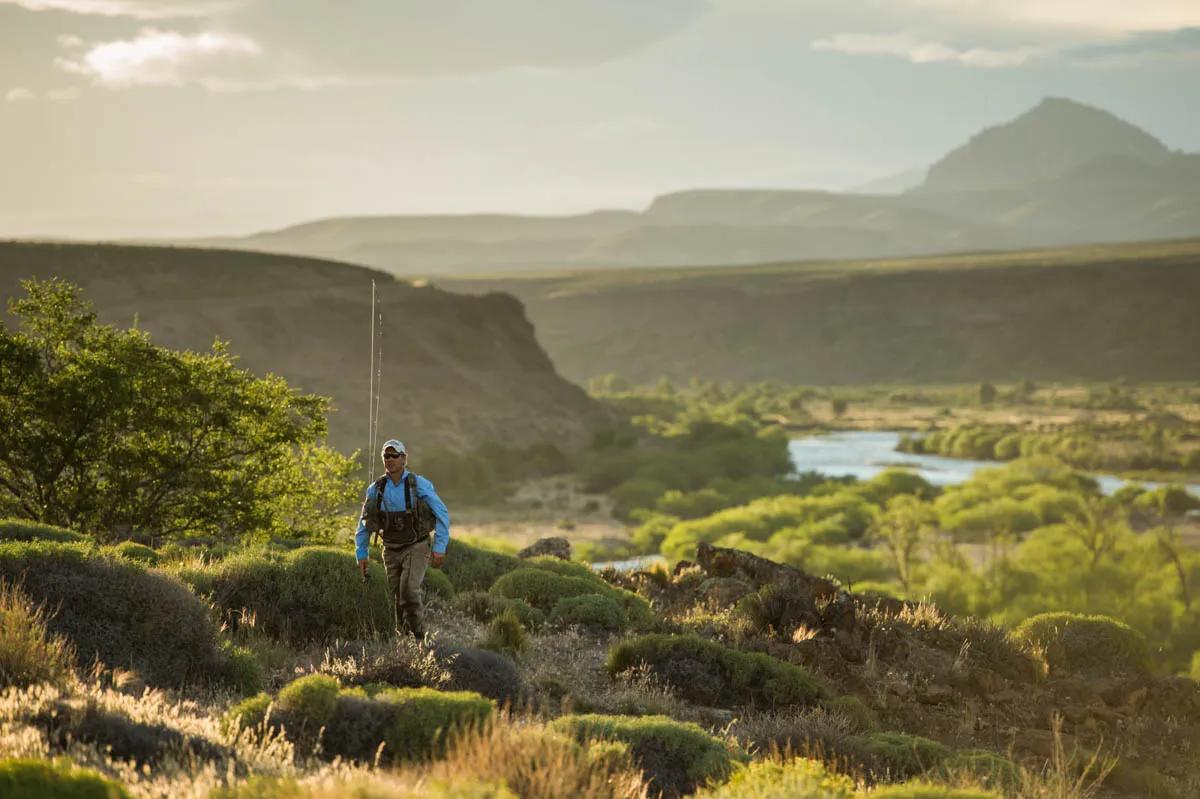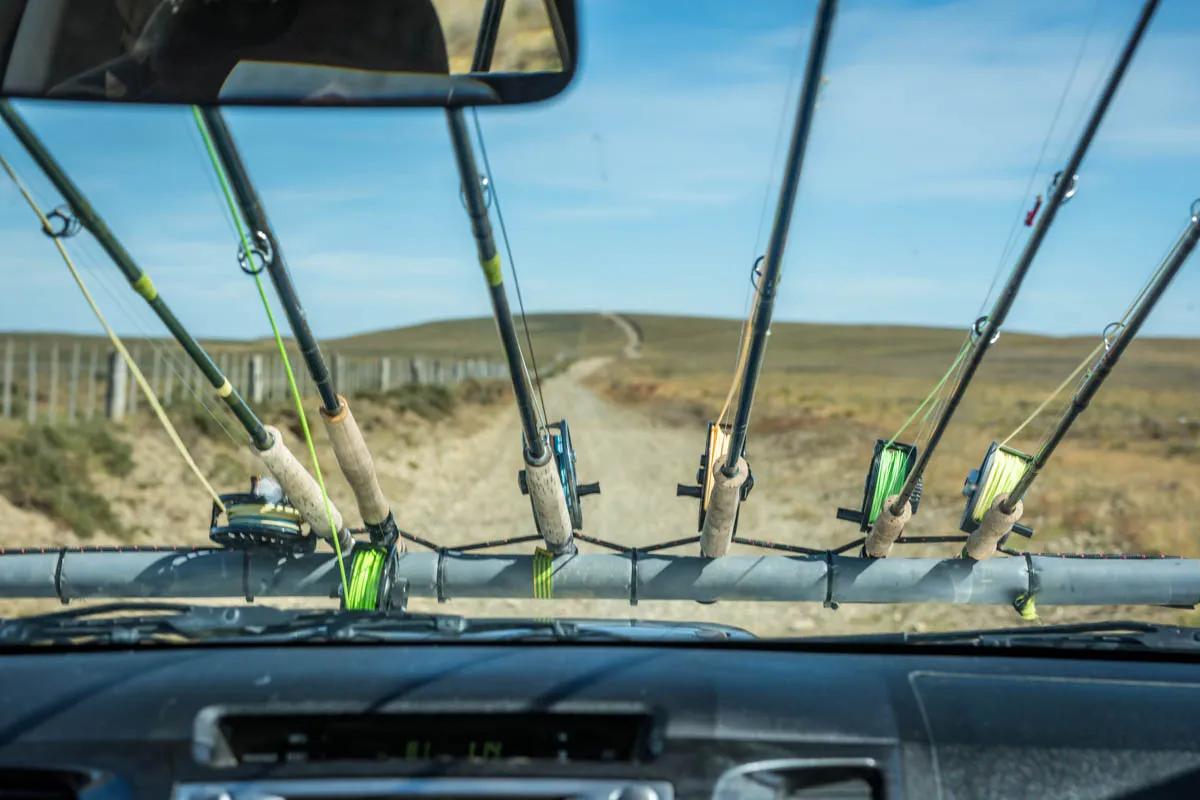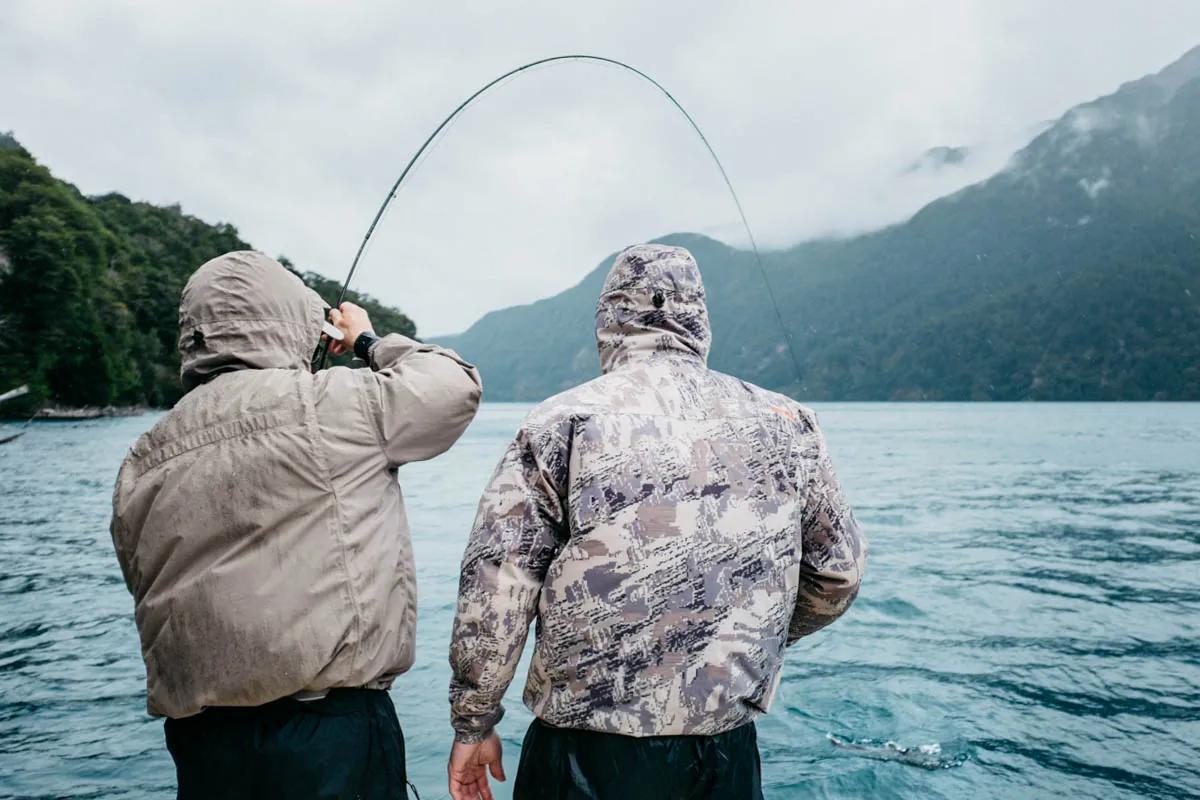
I’ll never forget my first fly-fishing trip to Patagonia. There was a palpable sense of anticipation – the sort that goes on for months, creeps into every discussion, has you exploring far-flung rivers on Google Earth at work. The moment I booked tickets I was consumed. And there’s a solid chance you will be, too.
Patagonia, that transfixing region of trout country that encompasses the southern portions of Chile and Argentina, is an angler’s dream. High mountain peaks draped in verdant belts of vegetation give way to lupine-lined rivers and aquamarine lakes in Chilean Patagonia. The Argentine pampa provides anglers a vivid and complex landscape reminiscent of the American West from a lost generation, with gauchos and guanaco standing in for cowboys and pronghorn.
Of course, there are regions of overlap in each country. Salmon from the Pacific and Atlantic oceans appear in both countries as the great rivers of the region weave their way through the Andes. Brown and rainbow trout are the primary quarry of anglers throughout Patagonia. You’ll find Spanish spoken across the region, empanadas and asado and wines that will delight the senses.

Throughout Patagonia you’ll also find wind, sometime gale force and persistent. Rain that can turn to snow any day of the season. Sailors once called the latitudes between 40 and 50 degrees south of the equator the "Roaring Forties". The weather here is legendary for a reason. Spend a week in Patagonia and you might well get blown off the water. But the next afternoon you’ll find yourself sitting in the shade of a lenga tree on the banks of a trout stream in the sunshine. And then a trout will rise.
So, the question comes: How does one pack for a place like Patagonia? What rods and reels are appropriate for the variety of fishing situations you’ll encounter? What sort of rain gear and waders make the most sense? How many warm layers do you pack?
Consider the following advice from a fellow traveler that has felt the brunt of Patagonia, caught a few of its fish, and been back for more.
Fishing tackle
Much of the same trout fishing tackle you’d fish with on Western trout streams in places like Wyoming, Montana and Colorado will serve you just fine in Patagonia. 5- and 6-weight, nine-foot rods suit the needs of anglers fishing everything from Chile’s Río Paloma to Argentina’s Lago Tromen. Large arbor reels are a good bet to retrieve line quickly. Nine-foot monofilament or fluorocarbon leaders tapered to 3X or 4X are standard. There is rarely a need to use lighter tippets but also bring some 1X and 2X if you love to throw streamers. There are some great streamer rivers in Patagonia and if you enjoy hunting for larger fish a 7 weight is also a nice option. While you can still throw a streamer on a 6 weight the 7 is a little bit better suited.

A 4-weight rod for creek fishing is worth packing if you plan to explore some of Patagonia’s more intimate fisheries. Spring creeks meander through many regions of the Argentine pampa and flow into some of the most popular rivers in Chile. These diversions from the major rivers offer technical dry-fly fishing when conditions are favorable and are best fished with lighter rods. We have also had many trips where 4 weights simply never left the lodge. If you bring 3 rods it is best to stick with a 5,6 and 7. If you bring two rods go with a 5 and 6.
Weight forward floating lines are a great match for your 5 and 6 weight rods. If you like throwing streamers also bring a long bellied sink tip. Sinking lines help get your fly down in the water column when fishing the swift rivers that cascade down off the Andes Mountains, they also help you cut through the wind when it blows. Pack along spare spools equipped with sink-tip lines for each of your reels. A 250-grain sink tip will help in a variety of situations. Take it out for a few casts in the backyard before you pack your bags as casting a weighted line can take a bit to get used to.
You don’t have to overthink your fly selection when packing for Patagonia: The standard assortment of attractor dries, nymphs and streamers will work well, and the local guides can provide patterns they’ve honed for specific waters. Do remember though that the wind can greatly impact fishing conditions. Packing a few low-profile dry flies that won’t get dragged all over the water when the wind blows is a good idea. Most of the lodges in both Chile and Argentina that we partner with include flies in the package so if you are headed to a lodge you don't need to worry about fly selection unless you want a small kit to have with you on the wade days when you are around the bend from the guide.

There is one bug worth carrying a few flies for if you are fortunate enough to be in Patagonia for the hatch. Cantaria beetles show up in southern Chile and Argentina from January to March. This isn’t typical dry fly fishing. Cantaria beetles are up to three inches in length. The males have enormous mandibles that can inflict a painful pinch. Needless to say, the trout go nuts for them. A few Fat Alberts or Grillos Cantaria Beetles tied in larger size will draw strikes.
While you might not head to Patagonia in pursuit of salmon, the sight of one breaching or glancing at your streamer will have you rethinking that notion in a hurry. Anglers interested in fishing for salmon should consider 7- to 9-weight rods. Switch and spey rods are becoming increasingly popular for those specifically targeting salmon. Fish over 20 pounds are regularly caught on many of the popular rivers throughout the region.
Outerwear
Bottom line: You are probably going to get wet fishing in Patagonia. If it’s not a storm sweeping north from the Antarctic Peninsula, it’ll be spray from the surface of a lake as you jet to your fishing spot for the day. You’re going to need a reliable pair of waders and a rain jacket that’s up to the task.

Patagonia presents anglers with a plethora of fishing situations, from tumbling mountain streams to massive rivers and mountain lakes. You’ll be fishing on foot and in and out of boats, a lot. You might even find yourself on horseback if you’re lucky. You’ll want to stay warm and dry to enjoy all of it.
Any of the latest and greatest waders from manufacturers like Orvis, Simms and Patagonia are solid choices. The determining factor for the traveling angler comes down to weight and bulk versus durability. While travelling light is certainly appealing for obvious reasons, when it comes to raingear for Patagonia, don’t skimp. Choose waders with 5-layer GORE-TEX or equivalent fabrics. A fabric-lined chest pocket is a nice option for warming chilled hands on long boat rides or after a serious session of streamer fishing.
Wading boots come in a variety of styles, but anything reasonably durable will do. Avoid boots with felt soles as they are challenging to dry and prone to the spread of aquatic invasive species.
Consider your rain jacket the way you would a pair of waders: It functions as a shell to keep the rain, wind and weather out, and the warmth in. Lightweight raingear is not the way to go in Patagonia. Find a jacket with multilayer protection from the elements. Three-layer GORE-TEX and equivalent fabrics are advised. Look for a jacket with a waterproof zipper and hood that can be tightened down in the wind. Armpit zips are a nice touch to help release body heat when the sun pokes through.

In addition to waders, boots and rain jacket, you’ll want a variety of layers to adjust for changing conditions. Bring a few base layers and some insulating layers and mix and match as needed to meet the needs of the day. A pair of synthetic light-weight pants is great for wet wading on days when the weather is favorable.
Odds and ends
Patagonia’s variable weather can demand a few wardrobe changes throughout the day so it’s nice to bring a small pack to stash your extra layers and fishing gear. Plan to bring a pack that is waterproof and provides easy access to spare spools, cell phones and additional clothing. Choosing a pack with a couple of different compartments is nice. It allows you to keep gear orderly and if you happen to be in a spot where you want to stow wet gear you can isolate it from other items in your pack.

The people, landscapes and trophy trout of Patagonia demand at least a photograph or two. If you’re inclined to travel with more than a cell phone to capture images, a decent camera is in order. The modern lineup of mirrorless cameras has largely supplanted the DSLR bodies of the early 2000s. These cameras tend to be smaller and lighter weight than DSLRs and are a good option for travelling anglers.
Lens options abound. A 24-70mm lens is a common zoom range produced by most manufacturers and is a good bet for all-around photography. If you’re really into imaging, consider a dedicated wide-angle lens and a dedicated telephoto lens to maximize your photographic pursuits.

Finally, remember to pack some comfortable clothing to change into back at the lodge. Dinner is a big deal in Patagonia and can range from formal to festive depending on the night. Outdoor asados (Patagonia style BBQs, usually set around an open fire) are common during lodge stays and a casual attire is the norm, but you’ll want a nice shirt and pair of pants for the dinner table. Pack a swimsuit, too. Many lodges in Patagonia feature wood-fired hot tubs. There is nothing like coming back from a day on the river and sliding in for a soak beneath the stars of the southern sky.
The great thing about planning a fishing trip is that one day it’s here. Be ready for the weather. Patagonia is ready for you.
